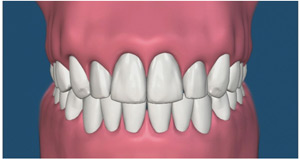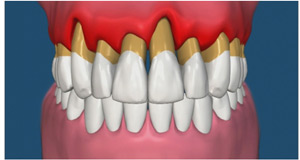Periodontal Disease
Bad News: Periodontal disease is the major cause of tooth loss in adults.
Good News: Periodontal disease, if detected early, can have very successful treatment results.
What Is Periodontal Disease?
Periodontal disease is an infection of the tissues that support your teeth. Periodontal diseases attack just below the gum line in the sulcus, where they cause the attachment of the tooth and its supporting tissues to break down. As the tissues are damaged, the sulcus develops into a pocket: Generally, the more severe the disease, the greater the depth of the pocket.
Periodontal diseases are classified according to the severity of the disease. The two major stages are gingivitis and periodontitis. Gingivitis is a milder and reversible form of periodontal disease that only affects the gums. Gingivitis may lead to more serious, destructive forms of periodontal disease called periodontitis.

Healthy Gums

The gums become swollen and begin to pull away from the teeth in later stages of periodontal disease.
Some factors increase the risk of developing periodontal disease:
- People who smoke or chew tobacco are more likely to have periodontal disease. And it's more likely to be more severe than in those who do not use any tobacco products.
- Some systemic disease, such as diabetes, can lower your body's resistance to infection, making periodontal diseases more severe.
- Many medications, such as steroids, some types of anti-epilepsy drugs, cancer therapy drugs, some calcium channel blockers, and oral contraceptives can affect the gums. In addition, medications that reduce your salivary flow can result in a chronically dry mouth, which can irritate your oral soft tissues. Let your dentist know about your medications and update your medical history files at the dental office when any changes occur.
- Bridges that no longer fit properly, crooked teeth or fillings that have become defective can contribute to plaque retention and increase your risk of developing periodontal disease.
- Pregnancy or use of oral contraceptives increases hormone levels that can cause gum tissue to be more sensitive to the toxins and enzymes produced by plaque and can accelerate growth of some bacteria. The gums are more likely to become red, tender and swollen, and bleed easily.
Several warning signs that can signal a problem:
- Gums that bleed easily
- Red, swollen, tender gums
- Gums that have pulled away from the teeth
- Persistent bad breath or bad taste
- Permanent teeth that are loose or separating
- Any change in the way your teeth fit together when you bite
- Any change in the fit of partial dentures
It is possible to have periodontal disease and have no warning signs. That is one reason why regular dental checkups and periodontal examinations are very important. Treatment methods depend upon the type of disease and how far the condition has progressed. Good oral hygiene at home is essential to help keep periodontal disease from becoming more serious or recurring. You don’t have to lose teeth to periodontal disease. Brush, clean between your teeth, eat a balanced diet, and schedule regular dental visits for a lifetime of healthy smiles.


